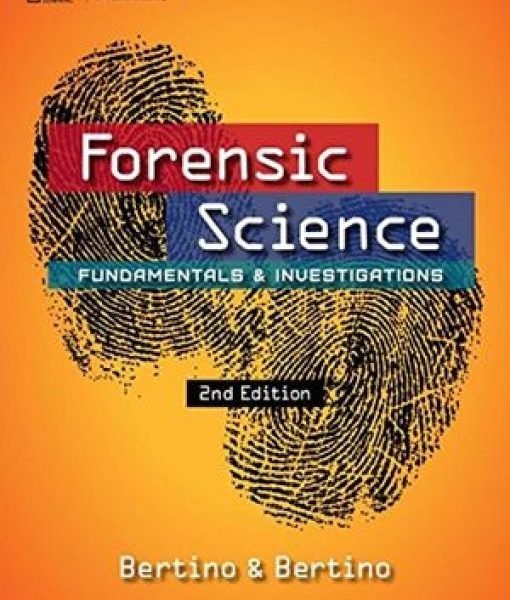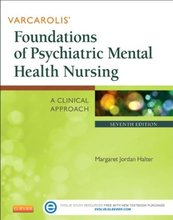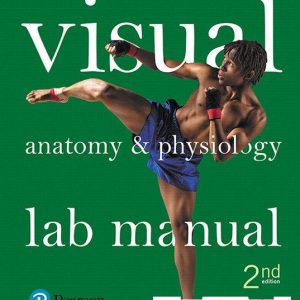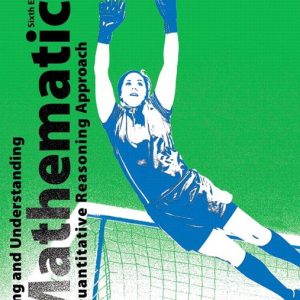This is completed downloadable of Forensic Science Fundamentals and Investigations 2nd Edition Test Bank Bertino

Product Details:
- ISBN-10 : 1305077113
- ISBN-13 : 978-1305077119
- Author:
With today’s popular television programs about criminal justice and crime scene investigation and the surge of detective movies and books, students often have a passion for exploring forensic science. Now you can guide that excitement into a profitable learning experience with the help of the innovative, new FORENSIC SCIENCE: FUNDAMENTALS AND INVESTIGATIONS, 2E. This dynamic, visually powerful text has been carefully crafted to ensure solid scientific content and an approach that delivers precisely what you need for your high school course. Now an established best-seller, FORENSIC SCIENCE: FUNDAMENTALS AND INVESTIGATIONS, 2E offers a truly experiential approach that engages students in active learning and emphasizes the application of integrated science in your course. Student materials combine math, chemistry, biology, physics, and earth science with content aligned to the National Science Education Standards, clearly identified by icons. This book balances extensive scientific concepts with hands-on classroom and lab activities, readings, intriguing case studies, and chapter-opening scenarios. The book’s exclusive Gale Forensic Science eCollection database provides instant access to hundreds of journals and Internet resources that spark the interest of today’s high school students. The new edition includes one new chapter on entomology and new capstone projects that integrate the concepts learned throughout the text. Comprehensive, time-saving teacher support and lab activities deliver exactly what you need to ensure that students receive a solid, integrated science education that keeps readers at all learning levels enthused about science. FORENSIC SCIENCE: FUNDAMENTALS AND INVESTIGATIONS, 2E sets the standard in high school forensic science . . . case closed.
Table of Content:
- Chapter 1 Review
- Activity 1-1 Learning to See
- Activity 1-2 You’re an Eyewitness!
- Activity 1-3 What Influences Our Observations?
- Chapter 2: Crime-Scene Investigation and Evidence Collection
- Introduction
- Principle of Exchange
- Types of Evidence
- The Crime-Scene Investigation Team
- The Seven S’s of Crime-Scene Investigation
- Analyze the Evidence
- Crime-Scene Reconstruction
- Staged Crime Scenes
- Summary
- Case Studies
- Careers in Forensics: Crime-Scene Investigator
- Chapter 2 Review
- Activity 2-1 Locard’s Principle of Exchange
- Activity 2-2 Crime-Scene Investigation
- Chapter 3: Hair Analysis
- Introduction
- History of Hair Analysis
- The Functions of Hair
- The Structure of Human Hair
- Summary
- Case Studies
- Careers in Forensics: William J. Walsh, Chemical Researcher
- Chapter 3 Review
- Activity 3-1 Trace Evidence: Hair
- Activity 3-2 Hair Measurement
- Activity 3-3 Hair Testimony Essay
- Chapter 4: A Study of Fibers and Textiles
- Introduction
- Collecting, Sampling, and Testing Fiber Evidence
- Evaluating Fiber Evidence
- Fiber and Textile Evidence
- Summary
- Case Studies
- Careers in Forensics: Irene Good
- Chapter 4 Review
- Activity 4-1 Microscopic Fiber Analysis
- Activity 4-2 Bedsheet Thread Count
- Activity 4-3 Weave Pattern Analysis
- Activity 4-4 Textile Identificat
- Activity 4-5 Burn Analysis of Fibers
- Chapter 5: Forensic Botany
- Introduction
- History of Forensic Botany
- How Forensic Botany Is Used to Solve Cases
- Drowning Victims
- Information from Gastric Contents
- The Body Covered by Wilted Sunflowers
- Secrets from a Grave
- Botanical Crime-Scene Analysis
- Searching for and Mapping Botanical Evidence
- Botanical Evidence Collection
- Pollen and Spores in Forensics
- Pollen Producers
- Spore Producers
- Pollen and Spore Identification in Solving Crimes
- Summary
- Case Studies
- Careers in Forensics: Dr. Lynne Milne, Forensic Palynologist
- Chapter 5 Review
- Activity 5-1 Pollen Examination: Matching a Suspect to a Crime Scene
- Activity 5-2 Pollen Expert Witness Presentation
- Activity 5-3 Botanical Evidence Case Studies Presentation
- Activity 5-4 Processing a Crime Scene for Botanical Evidence
- Activity 5-5 Pollen Index
- Activity 5-6 Isolation of Pollen from Honey
- Chapter 6: Fingerprints
- Introduction
- Historical Development
- What Are Fingerprints?
- Summary
- Case Studies
- Careers in Forensics: Peter Paul Biro
- Chapter 6 Review
- Activity 6-1 Study Your Fingerprints
- Activity 6-2 Giant Balloon Fingerprint
- Activity 6-3 Studying Latent and Plastic Fingerprints
- Activity 6-4 How to Print a Ten Card
- Activity 6-5 Is It Consistent?
- Activity 6-6 Fingerprint Analysis
- Activity 6-7 Using Cyanoacrylate to Recover Latent Fingerprints
- Chapter 7: DNA Profiling
- Introduction
- What Is DNA?
- Collection and Preservation of DNA Evidence
- Forensic DNA and Personal Identification
- Early DNA Fingerprinting Using Gel Electrophoresis
- Short Tandem Repeats (STRs)
- DNA STR Profiles
- Y STR and mtDNA Analyses
- Romanov Family Case Study Linking History and Forensics
- DNA and Forensic Science
- Summary
- Case Studies
- Careers in Forensics: Kary Banks Mullis, Nobel Prize-Winning Biochemist
- Chapter 7 Review
- Activity 7-1 Simple DNA Extraction
- Activity 7-2 The Break-In
- Activity 7-3 Anna Anderson or Anastasia? STR Analysis
- Activity 7-4 STR Identification of a September 11 Victim
- Activity 7-5 Identification of the Romanovs Using STR Profiling
- Chapter 8: Blood and Blood Spatter
- Introduction
- History of the Study of Blood
- Composition of Blood
- Blood-Spatter Patterns
- Crime-Scene Investigation of Blood
- Summary
- Case Studies
- Careers in Forensics: Bloodstain Pattern Analyst
- Chapter 8 Review
- Activity 8-1 A Presumptive Test for Blood
- Activity 8-2 Creating and Modeling Blood-Spatter Patterns
- Activity 8-3 Blood-Spatter Analysis: Effect of Height on Blood Drops
- Activity 8-4 Area of Convergence
- Activity 8-5 Blood-Droplet Impact Angle
- Activity 8-6 Area of Origin
- Activity 8-7 Crime-Scene Investigation
- Chapter 9: Forensic Toxicology
- Introduction
- Heavy Metals, Gases, Poisons, and Toxins
- Summary
- Case Studies
- Careers in Forensics: Dr. Don Catlin, Pharmacologist and Founder of Sports Drug Testing
- Chapter 9 Review
- Activity 9-1 Drug Analysis
- Activity 9-2 Should Medical Marijuana be Legalized?
- Activity 9-3 Drug Spot Test
- Chapter 10: Handwriting Analysis, Forgery, and Counterfeiting
- Introduction
- Early Forensic Handwriting Analysis
- Handwriting Characteristics
- Handwriting Analysis
- Forgery
- Counterfeiting
- Summary
- Case Studies
- Careers in Forensics: Lloyd Cunningham, Document Expert
- Chapter 10 Review
- Activity 10-1 Handwriting Analysis
- Activity 10-2 Analysis of Ransom Note and Report to Jury
- Activity 10-3 Examination of U.S. Currency: Is It Authentic or Counterfeit?
- Chapter 11: Forensic Entomology
- Introduction
- How Is Forensic Entomology Used?
- History of Forensic Entomology
- Insects and Decomposition
- Estimating Postmortem Interval
- Processing a Crime Scene for Insect Evidence
- Summary
- Case Studies
- Careers in Forensics
- Chapter 11 Review
- Activity 11-1 How to Raise Blowflies for Forensic Entomology
- Activity 11-2 Mini-Projects for Forensic Entomology
- Activity 11-3 Observation of Blowflies or Houseflies
- Activity 11-4 Factors Affecting Postmortem Interval Estimates and Accumulated Degree Hours
- Chapter 12: Death: Manner, Mechanism, Cause
- Introduction
- Manner of Death
- Cause and Mechanism of Death
- Body Changes after Death
- Postmortem Changes in the Eye
- Stages of Decomposition
- Summary
- Case Studies
- Careers in Forensics: Michael Baden
- Chapter 12 Review
- Activity 12-1 Calculating Postmortem Interval Using Rigor Mortis
- Activity 12-2 Calculating Postmortem Interval Using Algor Mortis
- Activity 12-3 Tommy the Tub
- Activity 12-4 Analysis of Evidence from Death Scenes
- Chapter 13: Soil Examination
- Introduction
- History of Forensic Soil Examination
- Soil Composition
- Sand
- Soil Evidence
- Summary
- Case Studies
- Careers in Forensics: Forensic Geologists
- Chapter 13 Review
- Activity 13-1 Examination of Sand
- Activity 13-2 Soil Evidence Examination
- Activity 13-3 Chemical and Physical Analysis of Sand
- Chapter 14: Forensic Anthropology
- Introduction
- Historical Development
- Characteristics of Bone
- Bones and Biological Profiles
- Skeletal Trauma Analysis
- Skeletal Evidence Collection and Examination
- Summary
- Case Studies
- Careers in Forensics: Dr. Clyde Snow: The Bone Digger
- Chapter 14 Review
- Activity 14-1 Determining the Age of a Skull
- Activity 14-2 Bones: Male or Female?
- Activity 14-3 Identifying the Romanovs – an Internet Activity
- Activity 14-4 Estimation of Body Size From Individual Bones
- Activity 14-5 What Bones Tell Us
- Activity 14-6 Height and Body Proportions
- Chapter 15: Glass Evidence
- Introduction
- What Is Glass?
- Types of Glass
- Properties of Glass
- Collection and Documenting Glass Evidence
- Summary
- Case Study
- Careers in Forensics: Criminalist
- Chapter 15 Review
- Activity 15-1 Glass Fracture Pattern Analysis
- Activity 15-2 Glass Density
- Activity 15-3 Approximating the Refractive Index of Glass Using a Submersion Test
- Activity 15-4 Determining the Refractive Index of Liquids Using Snell’s Law
- Chapter 16: Casts and Impressions
- Introduction
- Shoe and Foot Impressions
- Tire Treads and Impressions
- Dental Impressions
- Summary
- Case Studies
- Careers in Forensics: Before CSI, There Was Quincy; Before Quincy, There Was Thomas Noguchi
- Chapter 16 Review
- Activity 16-1 Making a Plaster of Paris Cast
- Activity 16-2 Shoe Size, Foot Size, and Height
- Activity 16-3 Tire Impressions and Analysis
- Activity 16-4 Vehicle Identification
- Activity 16-5 Dental Impressions
- Chapter 17: Tool Marks
- Introduction
- Tools and Crime Scenes
- Tool Marks
- Tool Surface Characteristics
- Tool Mark Evidence
- Analyzing Tool-Mark Evidence
- Summary
- Case Studies
- Careers in Forensics: Dr. David P. Baldwin and Colleagues, Forensic Scientists and Tool-Mark Experts
- Chapter 17 Review
- Activity 17-1 Tool Marks: Screwdrivers and Chisels
- Activity 17-2 Hammers and Hammer Impressions
- Activity 17-3 Casting Impressions of Hammer Strikes on Wood in Silicone
- Chapter 18: Firearms and Ballistics
- Introduction
- History of Gunpowder and Firearms
- Long Guns and Handguns
- Firearms and Rifling
- Bullets and Cartridges
- Evidence from Bullets and Cartridges
- Evidence from Spent Bullets and Wounds
- Trajectory
- Databases
- Ballistics Evidence Standards
- Summary
- Case Studies
- Careers in Forensics: Firearms Examiner
- Chapter 18 Review
- Activity 18-1 Bullet Trajectory
- Activity 18-2 Firing Pin Analysis
- Activity 18-3 Describing Spent Projectiles
- Activity 18-4 How Good Is Your Aim?
- Capstone Projects
- Project 1: Physical Evidence Case Studies
- Project 2: Personal Evidence Port
- Project 3: How Reliable Is the Evidence?
- Project 4: Landmark Cases in Acceptance of Eviden
- Project 5: Analysis of a Forensic Science TV Show Episode
- Project 6: Forensic Dumpster Diving – What the Garbage Can Tell Us
- Project 7: Forensic Science Career Exploration
- Project 8: Mock Crime-Scene Development and Processing
- Project 9: How to Read Calipers
- Project 10: Gravesite Excavation
- Glossary
- Appendix A: Table of Sines
- Appendix B: Table of Tangents
- Appendix C: Celsius-Fahrenheit Conversion Table
- Index





